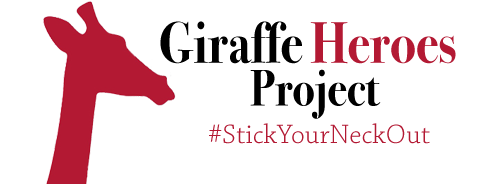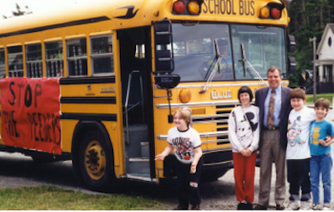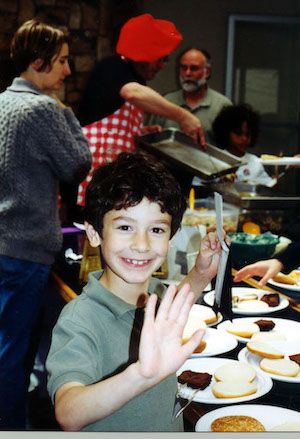Service Learning
Note: To read about Giraffe Hero service learning activities and materials in Spanish, click on APRENDIZAJE SERVICIO, above.
- What is it and why is it important?
- Best practices
- Challenges in service learning—and how to overcome them
- Resources
- Examples of service learning projects
Note: To read about Giraffe Hero service learning activities and materials in Spanish, click on APRENDIZAJE SERVICIO above.

WHAT IS SERVICE LEARNING?
Service learning is an educational method, developed in the United States in the early 1990’s, that integrates service projects with classroom learning. In the process of guiding students to identify and solve real problems in their communities (and farther afield), service learning teaches academic and life skills. Bygiving kids opportunities to reflect on and learn from experiences of service and active citizenship, service learning helps them build lives as courageous and compassionate citizens.
The U.S. National and Community Service Trust Act of 1993 identified the following six elements of service learning:
~ Students learn and develop through active participation in thoughtfully
~ Organized service that is conducted in and meets the needs of a community.
~ The service is integrated into and enhances the curriculum of the students. Academic subjects are integrated with related service learning projects. Examples are:
- Science & Environmental Science >>Cleaning up a wetland
- Social Studies>>Hunger/homelessness projects
- Public Health>>Working in an AIDS hospice
- Political Science & Civics>>Influencing a local political issue
~The service is done in connection with an elementary school, a secondary school, institutions of higher education, or community service programs and with the community.
~ The service helps foster civic responsibility.
~ Time is set aside for students to reflect on the service as they go along.
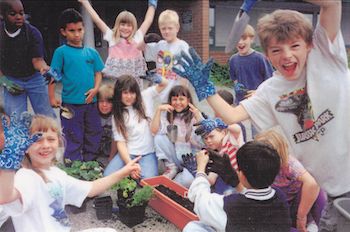
WHY IS SERVICE LEARNING IMPORTANT?
Over the past two and a half decades, teachers, administrators, and parents have come to understand that when service is linked to learning and placed at the core of the curriculum, the combination opens the door to the multi-faceted education all teachers want for young people, equipping them for their roles not just as learners, but as community members and workers too. And because service learning makes a positive contribution to communities as well, it has become an increasingly popular with community leaders and parents. Former California State Superintendent of Public Instruction Jack O’Connell put it this way: "Service learning makes academic content come alive as students apply their knowledge and skills to real-life situations. Students become more engaged in their studies and see that they can make a difference. Taking an active role in addressing community needs fosters responsible citizenship and contributes to character development."
The Giraffe Heroes Project, one of the leaders in the field, gives these reasons for why service learning is so important: Service learning—
•builds character. Good character is very hard to teach as a theory. As we all know, character lessons are more likely to stick in us if we go beyond concepts and actually put those lessons to work in our own lives. That’s how we, and kids, learn that values actually work in the world. For example, learning to care about something beyond self is important. But what drives that lesson home is putting that caring into action by actually carrying out a project that helps other people.
•fosters active citizenship and the practice of democracy.Students learn the complexity of problems in their community and the political, social and economic factors behind them. When they design and implement a service project that meets needs they care about, students become stakeholders in the community; they learn to care about what happens there. Students learn to express their concerns, lobby for their ideas, vote on ideas and projects, and raise money and other resources.
•provides opportunities to learn and practice academic skills in writing, speaking, social studies, visual arts, communication, teamwork, critical thinking, decision-making and—depending on the nature of the service project—mathematics, health, science and technology.
•provides opportunities to learn and practice important life skills.As they take on service projects, kids learn to plan, contribute to a team effort, resolve conflicts, speak in public, make good decisions and take responsibility.
• fosters students’ eagerness to learn.Students become so intent on succeeding with their service project that even those with a long record of academic failure find themselves acquiring and using academic skills—not as ends in themselves, but as the means for doing something they really want to do. Investigators have found that when rigorous study in academic disciplines is linked to serious work on real needs, students become eager to learn everything they need to do their project.
• builds confidence.Seeing the positive difference their actions can make in their communities gives a huge boost to kids’ confidence, as they see how valuable their actions can be.
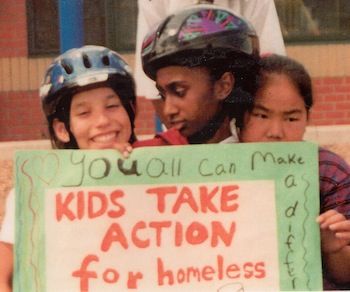
BEST PRACTICES IN SERVICE LEARNING
First principles:
• Service learning must truly balance “service” with “learning.” The effort to link service learning with academic standards shouldn’t be allowed to overwhelm the premise that service, and the active citizenship it promotes, are important goals in their own right.
• Service learning programs should include effective “street smart” guidance for planning and carrying out projects—so that communities are in fact served and kids get the personal impact and satisfaction of visible success as involved citizens of their communities.
• Service learning and character education should be linked. Service-action without moral reflection is of limited use. And moral reflection that is not deepened by action in the real world risks becoming only theory.
Important tips to teachers from the Giraffe Heroes Project’s 25 years of experience in the field
Service learning should be student-centered, that is, it almost certainly means giving students more responsibility than you may be comfortable with.Your role is as a coach and not a decision-maker. Challenge the kids to find out what they care about, and to decide amongst themselves what problems they feel are most important to solve in their community. Their next task is to create a service project that helps solve that problem, using their talents, their experience, and their resources. Don’t dictate what that project should be, but support the kids as they plan and carry it out.
As part of training kids to be good citizens, let them “rock a few boats.”If, in the course of an environmental lesson, for example, they discover that a local company is polluting the river, or that the town’s laws on pollution are lax, they may logically demand to challenge what they see as the first cause. Support them in doing that. This type of civic engagement is at the core of training them to be responsible citizens. Yes, they will make some mistakes—they’re young and inexperienced. Yes, you will want to check their letter to the CEO or the mayor and make sure the language is respectful and the grammar is OK, but don’t try to shut the students down or they will get exactly the wrong lesson—that they should never challenge authority, even if those authorities really need to make some changes.
Giving students the major responsibility for choosing, creating, planning and carrying out their project makes them stakeholders in solving the problem. That means that they’ll put more energy and enthusiasm into the work, and that the lessons they learn and the sense of satisfaction they gain are greater than if they’re simply told to show up at the soup kitchen at 6:00. When kids work on a project that they choose, their experience is that much more impactful on their spirits, their self-esteem and their likelihood of continuing in a life of active service.
Mandatory vs. voluntary service learning. It's always better if service learning is voluntary but sometimes it's mandated, by state or district requirements. This creates special problems because some kids will always resent being "forced" into a service project and may regard it as a punishment.
If you're in this situation, be prepared to spend extra time discussing with your students why service is important, which problems in the school or community concern them most, and what projects they might most enjoy doing. Give them as free a hand as you can in designing and carrying out the project, with your role being mentor and coach. And don't pass up opportunities to help them connect with the positive feelings gained from helping others.
Reflection is important to the success of any service project. Kids can resist or get cynical about doing projects, especially if they see them as mandated work, or just as a means of satisfying a graduation requirement. They need to reflect on what they are doing and why, and on the results and on how they feel. Specifically—
a) When students reflect on what works and what doesn’t work in how they’ve tried to solve a problem, they can better decide how to improve their performance in the future.
b) When students reflect on the causes of the problems they are helping solve, they become more aware of their complexity—and more savvy about solving them. They also learn in much more detail how their community really works.
c) When students reflect on how they feelabout getting involved in service work, and about what they might be learning about themselves in the process—they gain lessons that will serve them—and their future families, communities and workplaces.
Emphasize “community” in community service. When students design and implement a service project outside the class, especially one they’ve chosen themselves, they learn to care what’s happening in their larger community. They become part of the civic core who care about the common good. This is the essence of good citizenship.
It’s also important to involve the community that’s being served. Any service project should be reciprocal. There should be meaningful roles for the recipients of the service in both planning and carrying out the project—it shouldn’t just “doing for” people but “doing with.”
Start with the big kids. If you're introducing service learning in an entire school, start with the older grades. Younger kids will look up to what older kids are doing, but the reverse is not often true.

OBSTACLES TO IMPLEMENTING SERVICE LEARNING—AND HOW TO OVERCOME THEM
Experience shows that there are two major institutional obstacles to implementing successful service learning programs.
The challenge of change.Service-learning is not part of traditional pedagogies. Many educational leaders who recognize service learning’s value still have a hard time making it “fit” in their institutions. This challenge arises when any organization adopts what students of organizational behavior call a “disruptive innovation.” If a school chooses an innovative teaching method such as service learning, it will not take hold unless the school’s values and operating norms support the practice.
The core challenge thus facing those who support service learning is to improve, spread, and sustain service learning practice. Strategic leadership and advocacy are essential. There is strength in numbers: service learning supporters need to organize behind a collective agenda for increasing the scope and quality of the practice.
In schools where service learning flourishes, leaders create the right context for it by fostering the values of caring and contributing, pursuing public education’s civic purposes, supporting effective teaching, and seeking partnerships with community institutions. Where service learning has been given a chance to work, its distinctive effects on student learning confer advantages that few other pedagogies can match.
Not enough time in the school day.Many schools and teacherssimply can’t find the time during an already overburdened school day to insert yet another innovation. The response to this challenge is to emphasize the “learning” part of “service learning” that is, that service learning, as noted above, provides opportunities to learn and practice academic skills in writing, speaking, social studies, visual arts, communication, teamwork, critical thinking, decision-making and—depending on the nature of the service project—mathematics, health, science and technology. Depending on the program design, for example, preparing for a project requires reading for comprehension and vocabulary, and learning to do effective research. Communicating to local leaders and citizens and fundraising builds competence in both writing and public speaking. Taking measurements and figuring out budgets involves mathematics. Learning about community problems and issues is social studies.
You get the point. With a little reflection you should be able to come up with a convincing case that the skills-building that is an integral part of service learning belongs in any standard school pedagogy. It does not subtract from what student should be learning in the school day but adds to it.
Finally, you can emphasize two other points made just above, that service learning:
•provides opportunities to learn and practice important life skills.As they take on service projects, kids learn to plan, work in teams, fundraise, resolve conflicts, speak in public, make good decisions and take responsibility.
• fosters students’ eagerness to learn.
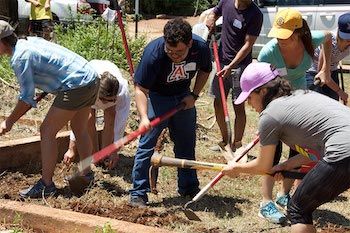
SOME RESOURCES
Argentina Ministry of Education: Programa Nacional Educación Solidaria(National Solidarity Education Program)
Europe Engage, the European service learning network in higher education, focuses on the role of service learning in the construction of a global citizenship
The Generator School Networkis an online community resource for fast and easy sharing, service learning professional development, and networking.
Giraffe Heroes Project: For Teachers & Families. A pioneer in the practice of service learning
Marquette University: Service Learning Bibliography
National Service Learning Clearinghouse
National Service Learning Cooperative: Essential Elements of Service Learning Practice
New York City Dept of Education: Service learning Opportunities and Resources
North Carolina Service Learning Coalition: a membership organization with good ideas

EXAMPLES OF SERVICE LEARNING PROJECTS
In this section, we share the stories of young people who have worked collaboratively to design and carry out service projects as part of service learning programs—applying the learning gained at school to real life projects that make things better in their schools and communities.
We invite you to share your experiences as a way of inspiring and informing your colleagues. Send your reports to Projects@giraffe.org.
This project promotes reading and the pleasure of reading literature in children, teenagers and young people. It was designed and launched by children in Primary School No. 16 (called Vicente López y Planes) in San Miguel del Monte, Buenos Aires, Argentina
Students from first to sixth grade, practically the whole school, actively participated in this project although the project itself was conceived in the language and literature area. What is peculiar about this experience is that the library that the children are proposing is neither a school library nor an ordinary and traditional one; it is a neighbourhood outdoor library. The library is set up in parks and squares in different neighbourhoods and the books are kept in fridges that are no longer in use.
The students at this school have planned this project so as to promote reading in public places, squares, parks, neighbourhood centres, hospital waiting rooms, etc. The initiative came from the children themselves, given the fact that there is a book fair held at the institution every year.
The aim of the project is to enjoy reading and, at the same time, the project was conceived because there are very few books in the school library and there is only one neighbourhood library in the area, which charges a fee to become a member.
moreThe Discovery School in Coupeville, Washington USA is a public school for kids who've had problems with school work and discipline. When one class at the school took on a service learning program, things really changed. The kids started by asking themselves what issue they cared about. The choice was easy. A student had almost been hit by a car speeding past the school grounds, ignoring the speed limit to get to the nearby ferry landing. The kids knew that this wasn't the only near-miss, and if something wasn't done, somebody was going to get seriously hurt. Making the streets around their school safe was their issue.
The students started off their project by videotaping speeding cars, clocking them, and graphing the results. Then they interviewed workers in the area about near-misses these people had seen. With that data in hand, they got a State trooper to confirm their findings with his radar gun. They got one of the county commissioners to visit their school, to see the problem for himself, then made a formal presentation to all the commissioners. The result was a $12,000 traffic light, a crosswalk and the admiration of everyone who witnessed what they'd accomplished. The students themselves experienced the satisfaction of service, the power of teamwork—and their own value as people who could get an important job done.
moreSpecial needs School “Juana Manso”, Villa Allende, Córdoba province, Argentina.
Fourth, fifth and sixth year students from the special needs school “Juana Manso” who are specialised in carpentry have carried out two consecutive service learning experiences. The first one involved building one-piece aluminium folding canes for the visually impaired and people with low vision who could not afford them. The second one was derived from the first and involved the making of Braille signage to be displayed on the streets of the city.
In 2017, the students received a letter from the rehabilitation centre “Julián Baquero” which stated the difficulty it ran into when acquiring the elements they needed for patients who were undergoing treatment at the institution. This centre operates in the same town in which the school is located and it offers treatment to a wide number of adult blind people, people with low vision and people who are deaf-blind.
The students thought of addressing the lack of canes for these people, much needed to be able to lead normal lives and they carried out a project to make them. The students learnt that these canes are different from the wooden ones made for leaning on: they can be folded and are made of aluminium.
moreThe effect of the Giraffe Heroes program on students can be profound. My name is Kathy Frazier and I’m an elementary/middle school gifted teacher in Kent, Ohio, USA. Let me tell you about just one of the many kids I’ve guided through the program.
Kyle was in my third grade class and after a class discussion on homelessness, said, "My mom, my sister and I stayed in the homeless shelter right here in our city for a whole month. It's a very nice place, but I think maybe they could use some blankets too." He looked around the class. "What do say? Do you think we should help them?"
The class was inspired by Kyle. Before the bell rang they decided to do “Project Blankets.” The next day they created a plan and in no time they had made a big donation box and created posters and announcements.
But it didn’t work. After two weeks of promoting their project, the blanket box held only two blankets . The kids were frustrated and disappointed. It was time for me to ask, “Why do you think kids aren’t donating to our project?”
It turned out that most of the students in the school didn’t have any extra blankets at home nor the money to buy new ones. There were a lot of long faces in the room until Kyle again spoke up.
moreSecondary school No. 45 “Presidente Sarmiento”, Huillapima, Catamarca province, Argentina.
"Oral history as a tool for the meeting of generations and as a possibility to tell our story"In 2017, with an assignment done in class designed to assess local needs, students from sixth year took up the challenge of getting the protagonists of the history of Huillapima back. During this process, they identified the lack of general knowledge about the history of the town and its heritage. As part of this issue, they identified many streets that did not have a name and others that had it, but little or nothing was known about who they were referring to.
Using the techniques of oral history, the students gathered information and presented ordinance projects to name the streets of the town.
To compile the different stories, the students discussed selection criteria in order to establish who was considered important and why, by means of surveys and interviews with neighbours. They later investigated the lives of ten of the selected people by the community, wrote the biographies and translated them into English. The students made bilingual bookmarks and a small book to disseminate their findings, and they were part of the ordinance projects that they presented to the local Council to name the streets that did not have one, which included the street in which the institution was located.
moreNeil Brier, who teaches eighth-grade Life Skills classes at Cardigan Mountain School in Canaan NH USA, has been using the Giraffe Heroes Program for several years. The most unusual service project his kids have chosen to do involves bats. The kids got interested in bats when an old school nearby was converted into an inn. The largest bat population in New England was living in the building's attic. To head off the possible execution of the bats, the kids decided to educate the community on how cool bats are.
They did presentations throughout the community, explaining the bat's role in the ecosystem (one bat eats 2,000 mosquitoes every night and bat guano is excellent fertilizer). The kids discovered that one of the school's maintenance workers was a bat hobbyist who was eager to teach them how to make and place bathouses; the woodshop teacher helped the kids build them. The students enlisted the cooperation of the inn's owners and were allowed to make and place bathouses around the inn building. Instead of being killed, the bats moved from the attic to attractive new housing.
more.These fifth and sixth year students from the Agricultural Technical Provincial School No. 7 (named“Ing. Ricardo Jorge Hueda") in Perico, in the Province of Jujuy, Argentina, together with their chemistry teacher, started a project related to the problem of environmental pollution by carbon monoxide.
The project aims to contribute to the reduction of greenhouse gases produced by the burning of fossil fuels in the area, although the main concern is related to indoor air pollution. This concern arose in the classroom due to the complications derived from the use of coal in heaters and cookers. The students carried out research and debated about the material that could substitute coal and how, and tested the effects of using a plant called tuna (prickly pear)as a replacement.
The students focused on the study of the tunato replace coal, which is dangerous and is used by the majority of the population to cook and heat homes and rooms.
Thetuna is a plant of the cactus species that can be found in the northern part of Argentina, among other regions. It requires little or no care and is rich in glucose and that is the reason why a substance capable of combustion can be obtained from it and replace the use of coal in homes.
more“Protect me”—a project to increase awareness of the importance of mandatory annual vaccinations, launched in 2015 by students from Secondary School No. 75, Villa Pomán, Catamarca, Argentina.
When they learned about the importance of vaccinations from local health workers, the students of School No. 75 determined to do something about the low rate of vaccinations in their town. They first designed a questionnaire to find out more about the health conditions of the 1100 local families. Before interviewing anyone, the students learned effective techniques for approaching people with their questions, including house visits, community festivals and talks at health care centres. At each meeting the students gave out leaflets in order to raise awareness of the importance of vaccination.
The result was not only an increase in the number of children vaccinated but an increasing awareness in the community of health issues, and the right to health.
As to academic lessons: in chemistry, the students analysed the composition of vaccines and their classification; in biology, they studied the immune system and the history of vaccines; in language arts they learned how to write effective communications and to do in-depth research; in IT they encouraged the use of ICT, and in ethical and citizenship training they investigated the respective roles and responsibility of the state and individuals in the implementation of healthy policies and practices.
moreKids today just watch television and make trouble, right? Wrong. Consider the swamp Kids, 12 sixth and seventh graders in Franklin County, Georgia, USA. “Swamp” stands for Solid Waste Management Plan, which is what these kids wrote and delivered to their county government! Implementation of their 756-page plan has extended the life of Franklin County’s dump by at least 20 years.
It all started when the kids brainstormed ways they could help lighten the loads of trash going into the dump. They could do recycling projects in their town, and an educational campaign on using less and re-using what people already had. But State law said every county must have a plan for dealing with its solid wastes; Franklin was months away from a $10,000-a-day fine for having no plan.
The kids decided they could write the needed plan. Presenting their case to startled officials, they proved they already knew more than anybody around about waste management—they’d done plenty of homework. They got a green light and set to work.
As they got deeper and deeper into Franklin’s trash, the kids challenged the county’s data on how much waste was being generated. They countered a plan to close the dump and pay high fees to truck wastes out of the county, proving that wise use of the landfill would keep it going—their plan reduced intake at the site by 25%.
moreTextures to Learn—a project to design and prepare specially-adapted materials for blind and visually impaired children, launched by students in School No. 1-102 “Entre Ríos”General Alvear, Mendoza, Argentina.
In 2013, when a blind girl joined their school, her classmates became aware of the shortage of didactic material for blind people and the difficulties that this entailed and decided to do something about it: they started producing the material themselves. In 2016, the children decided to expand the recipients of the project and included students from other schools.
The students produced handcrafted didactic material in which they use the Braille system. To begin, they conducted a series of interviews with professionals specialized in blindness and visual impairment, and they were advised by specialist teachers in the field. They used the information and training received to produce quality functional pieces, books, number puzzles and card games that are not on the market. They produced Braille signs in foam and expanded polyethylene and designed and created textured books on the topics suggested by the teachers.
They also made maps with different textures to recognise the provinces of the country. An important aspect of the project is the use of recyclable materials. During the course of this project, students learned and practiced skills in the areas arts, language and literature, mathematics, IT, music, social sciences and natural sciences.The students who participated in the experience also learned to work in integrated teams and to jointly plan effective actions.
moreTwo years ago the 2nd grade class at Lafayette Elementary in West Seattle , USA decided that they wanted to do something about littering. This turned into a two-part project. The first part was a neighborhood litter pick-up. The kids thoroughly enjoyed being outside, running down any piece of trash they could find. Their enthusiasm was elevated to near frenzy when one boy, Ceferino, found a $5 bill in the bushes. Word spread quickly among the teams that there was “GOLD “ to be found out there.
As we walked along the sidewalks, business owners of several small shops came out to ask what we were doing. The kids shouted that they were picking up litter. Smiles replaced the concerned looks on the owners’ faces and they showered the kids with Thank you's.
Soon we approached the neighboring high school, which the class already had determined to be the home of the worst littering of all. This turned out to true. The kids picked up a lot of litter, especially from the bushes around the school.
In fact, the littering at the high school was so bad that it sparked the second part of the kids’ project—writing and performing a play about litter, based on the book, “The Wizard of Wartsville.” The gist of the plot is that Mother Nature gives the Wizard a special power to make litter stick to people who throw it, just by pointing his finger at them.
more